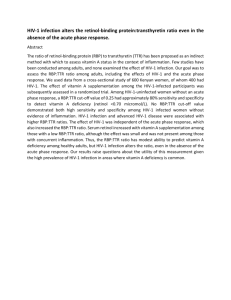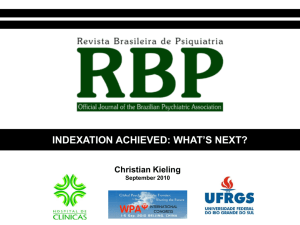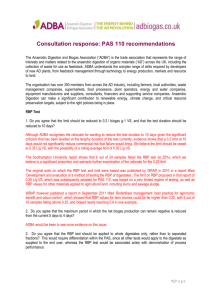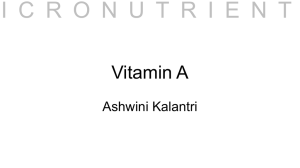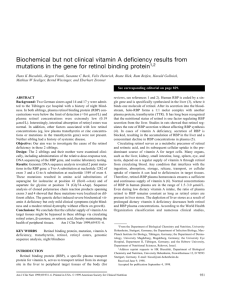Supplemental Materials for STRA6-Catalyzed Vitamin A Influx, Efflux
advertisement
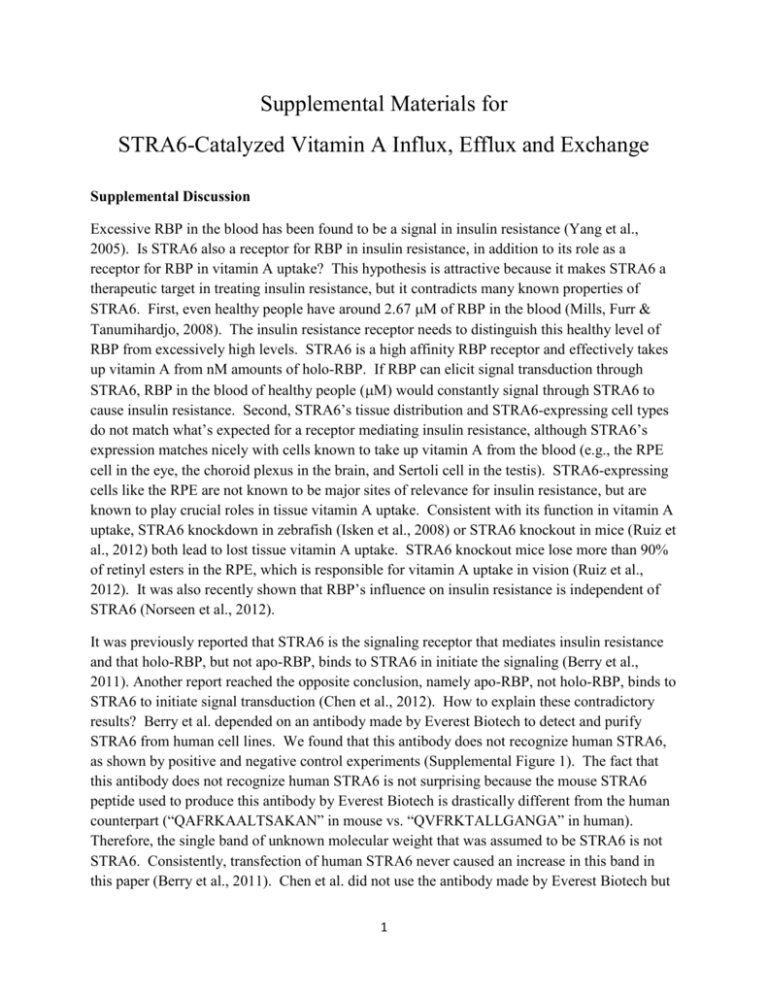
Supplemental Materials for STRA6-Catalyzed Vitamin A Influx, Efflux and Exchange Supplemental Discussion Excessive RBP in the blood has been found to be a signal in insulin resistance (Yang et al., 2005). Is STRA6 also a receptor for RBP in insulin resistance, in addition to its role as a receptor for RBP in vitamin A uptake? This hypothesis is attractive because it makes STRA6 a therapeutic target in treating insulin resistance, but it contradicts many known properties of STRA6. First, even healthy people have around 2.67 M of RBP in the blood (Mills, Furr & Tanumihardjo, 2008). The insulin resistance receptor needs to distinguish this healthy level of RBP from excessively high levels. STRA6 is a high affinity RBP receptor and effectively takes up vitamin A from nM amounts of holo-RBP. If RBP can elicit signal transduction through STRA6, RBP in the blood of healthy people (M) would constantly signal through STRA6 to cause insulin resistance. Second, STRA6’s tissue distribution and STRA6-expressing cell types do not match what’s expected for a receptor mediating insulin resistance, although STRA6’s expression matches nicely with cells known to take up vitamin A from the blood (e.g., the RPE cell in the eye, the choroid plexus in the brain, and Sertoli cell in the testis). STRA6-expressing cells like the RPE are not known to be major sites of relevance for insulin resistance, but are known to play crucial roles in tissue vitamin A uptake. Consistent with its function in vitamin A uptake, STRA6 knockdown in zebrafish (Isken et al., 2008) or STRA6 knockout in mice (Ruiz et al., 2012) both lead to lost tissue vitamin A uptake. STRA6 knockout mice lose more than 90% of retinyl esters in the RPE, which is responsible for vitamin A uptake in vision (Ruiz et al., 2012). It was also recently shown that RBP’s influence on insulin resistance is independent of STRA6 (Norseen et al., 2012). It was previously reported that STRA6 is the signaling receptor that mediates insulin resistance and that holo-RBP, but not apo-RBP, binds to STRA6 in initiate the signaling (Berry et al., 2011). Another report reached the opposite conclusion, namely apo-RBP, not holo-RBP, binds to STRA6 to initiate signal transduction (Chen et al., 2012). How to explain these contradictory results? Berry et al. depended on an antibody made by Everest Biotech to detect and purify STRA6 from human cell lines. We found that this antibody does not recognize human STRA6, as shown by positive and negative control experiments (Supplemental Figure 1). The fact that this antibody does not recognize human STRA6 is not surprising because the mouse STRA6 peptide used to produce this antibody by Everest Biotech is drastically different from the human counterpart (“QAFRKAALTSAKAN” in mouse vs. “QVFRKTALLGANGA” in human). Therefore, the single band of unknown molecular weight that was assumed to be STRA6 is not STRA6. Consistently, transfection of human STRA6 never caused an increase in this band in this paper (Berry et al., 2011). Chen et al. did not use the antibody made by Everest Biotech but 1 an antibody made by R&D Systems to detect and purify human STRA6. The R&D Systems antibody does recognize human STRA6 but also other nonspecific proteins (Supplemental Fig. 1). This study claimed that the RBP/STRA6 complex can be purified by immunoprecipitation of STRA6. This claim seems unlikely because RBP/STRA6 interaction is transient and the procedures of immunoprecipitation (including membrane solubilization, removal of insoluble materials, binding, washing and elution) take much longer than the interaction time of RBP/STRA6. A transient interaction between RBP and STRA6 makes physiological sense because each RBP molecule only delivers one vitamin A molecule and a transient interaction makes it possible for RBP to deliver the next vitamin A. In addition, STRA6 is unstable in detergents such as Triton, CHAPS, Brij 97, digitonin and FOS-12 and can no longer interact with RBP when solubilized in these detergents even transiently (data not shown). These are the major reasons that photocrosslinking to stabilize the RBP/STRA6 interaction was necessary to purify the complex and to identify STRA6 as the RBP receptor (Kawaguchi et al., 2007). In addition to the identity of STRA6, the sources of RBP used in these two studies are also different from this and previous studies on STRA6, which used HPLC-purified RBP or natural RBP in serum (Golczak et al., 2008; Isken et al., 2008; Kawaguchi et al., 2007). Berry et al. extracted retinol out of holo-RBP and used free retinol mixed with apo-RBP in solution, not holo-RBP, was used as a substitute for holo-RBP. Because holo-RBP does not readily release retinol and apo-RBP by itself very inefficiently takes up free retinol, it is not clear why this extraction was done and whether the RBP preparation has been purified by HPLC because bacteria-produced RBP has many species of incorrectly folded RBP without HPLC purification. Chen et al. used urine RBP mixed with retinoic acid, not retinol, was used as holo-RBP (Chen et al., 2012). Urine RBP has long been known to have a different amino acid composition from the holo-RBP in the blood and exists as multiple species (Peterson & Berggard, 1971; Rask, Vahlquist & Peterson, 1971). Retinoic acid, the biologically active form of retinol, can have a direct impact on cellular signaling. These are likely some of the reasons responsible for the opposite conclusions reached by these studies on the interaction of STRA6 with RBP. Supplemental References Berry, D.C., Jin, H., Majumdar, A., Noy, N. 2011. Signaling by vitamin A and retinol-binding protein regulates gene expression to inhibit insulin responses. Proc Natl Acad Sci U S A 108:4340-5 Chen, C.H., Hsieh, T.J., Lin, K.D., Lin, H.Y., Lee, M.Y., Hung, W.W., Hsiao, P.J., Shin, S.J. 2012. Increased unbound retinol binding protein 4 concentration induced apoptosis through its receptor-mediated signaling. J Biol Chem Golczak, M., Maeda, A., Bereta, G., Maeda, T., Kiser, P.D., Hunzelmann, S., von Lintig, J., Blaner, W.S., Palczewski, K. 2008. Metabolic basis of visual cycle inhibition by retinoid and nonretinoid compounds in the vertebrate retina. J Biol Chem 283:9543-54 Isken, A., Golczak, M., Oberhauser, V., Hunzelmann, S., Driever, W., Imanishi, Y., Palczewski, K., von Lintig, J. 2008. RBP4 Disrupts Vitamin A Uptake Homeostasis in a STRA6Deficient Animal Model for Matthew-Wood Syndrome. Cell Metab 7:258-68 2 Kawaguchi, R., Yu, J., Honda, J., Hu, J., Whitelegge, J., Ping, P., Wiita, P., Bok, D., Sun, H. 2007. A membrane receptor for retinol binding protein mediates cellular uptake of vitamin A. Science 315:820-5 Mills, J.P., Furr, H.C., Tanumihardjo, S.A. 2008. Retinol to retinol-binding protein (RBP) is low in obese adults due to elevated apo-RBP. Exp Biol Med (Maywood) 233:1255-61 Norseen, J., Hosooka, T., Hammarstedt, A., Yore, M.M., Kant, S., Aryal, P., Kiernan, U.A., Phillips, D.A., Maruyama, H., Kraus, B.J., Usheva, A., Davis, R.J., Smith, U., Kahn, B.B. 2012. Retinol-Binding Protein 4 Inhibits Insulin Signaling in Adipocytes by Inducing Proinflammatory Cytokines in Macrophages through a c-Jun N-Terminal Kinase- and Toll-Like Receptor 4-Dependent and Retinol-Independent Mechanism. Mol Cell Biol 32:2010-9 Peterson, P.A., Berggard, I. 1971. Isolation and properties of a human retinol-transporting protein. J Biol Chem 246:25-33 Rask, L., Vahlquist, A., Peterson, P.A. 1971. Studies on two physiological forms of the human retinol-binding protein differing in vitamin A and arginine content. J Biol Chem 246:6638-46 Ruiz, A., Mark, M., Jacobs, H., Klopfenstein, M., Hu, J., Lloyd, M., Habib, S., Tosha, C., Radu, R.A., Ghyselinck, N.B., Nusinowitz, S., Bok, D. 2012. Retinoid content, visual responses and ocular morphology are compromised in the retinas of mice lacking the retinolbinding protein receptor, STRA6. Invest Ophthalmol Vis Sci In press Yang, Q., Graham, T.E., Mody, N., Preitner, F., Peroni, O.D., Zabolotny, J.M., Kotani, K., Quadro, L., Kahn, B.B. 2005. Serum retinol binding protein 4 contributes to insulin resistance in obesity and type 2 diabetes. Nature 436:356-62 3 Supplemental Fig. 1. Western blot analyses of the human STRA6 protein. Molecular weight markers are shown on the right. a. Detection of Myc-tagged human STRA6 (hSTRA6-Myc) on Western blot by anti-Myc antibody (left panel), anti-human STRA6 antibody made by R&D (middle panel), and anti-mouse STRA6 antibody made by Everest Biotech (right panel). The first lane of each blot is membrane from COS-1 cells that do not express hSTRA6-Myc and the second lane is membrane from COS-1 cells that express hSTRA6-Myc. Only the anti-Myc antibody specifically recognizes the STRA6 protein and detects no nonspecific proteins in the negative control membrane. The R&D Systems antibody used by Chen et al. to detect and purify human STRA6 does recognize human STRA6 monomer but also recognizes other nonspecific proteins. The Everest Biotech antibody used by Berry et al. to detect and purify human STRA6 does not recognize human STRA6, but recognizes many other nonspecific proteins. Total cell lysate is expected to be even more complex than the membrane fraction. STRA6 monomer of 72 kD molecular weight is indicated by the arrowhead. Like many multitransmembrane domain proteins, STRA6 tends to aggregates in SDS-PAGE, especially if the sample is heated before loading. b. Detection of untagged human STRA6 (hSTRA6) on Western blot using anti-human STRA6 antibody made by R&D Systems (middle panel) and anti-mouse STRA6 antibody made by Everest Biotech (right panel). 4

